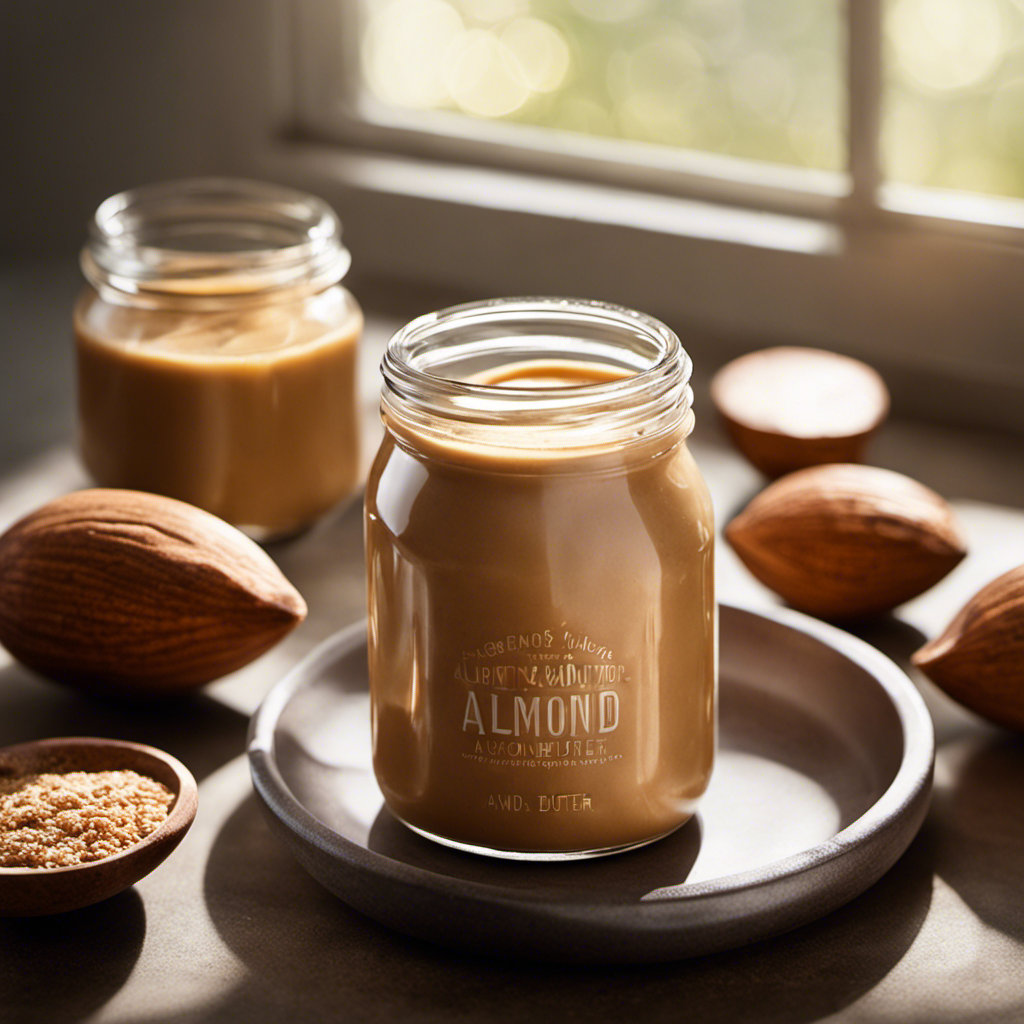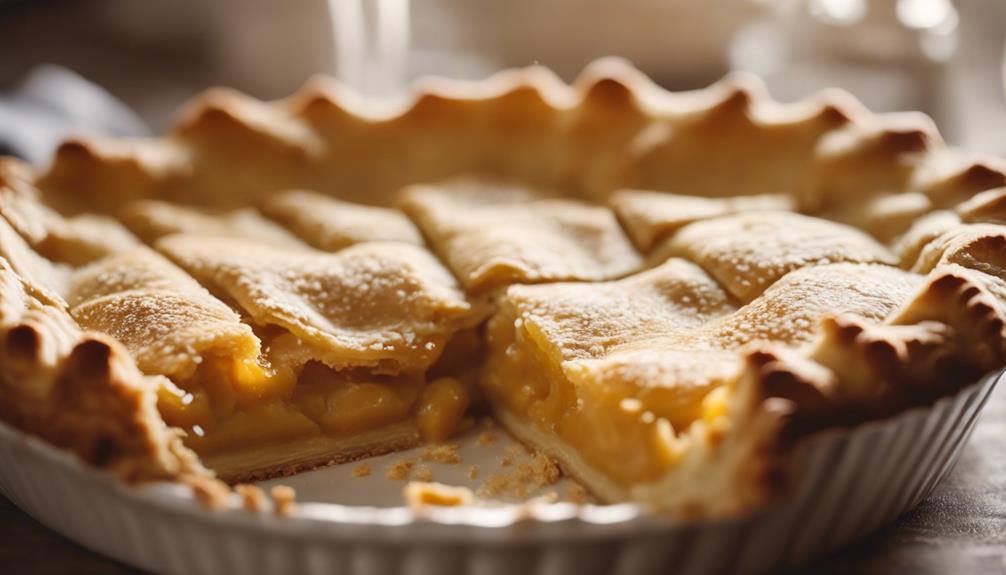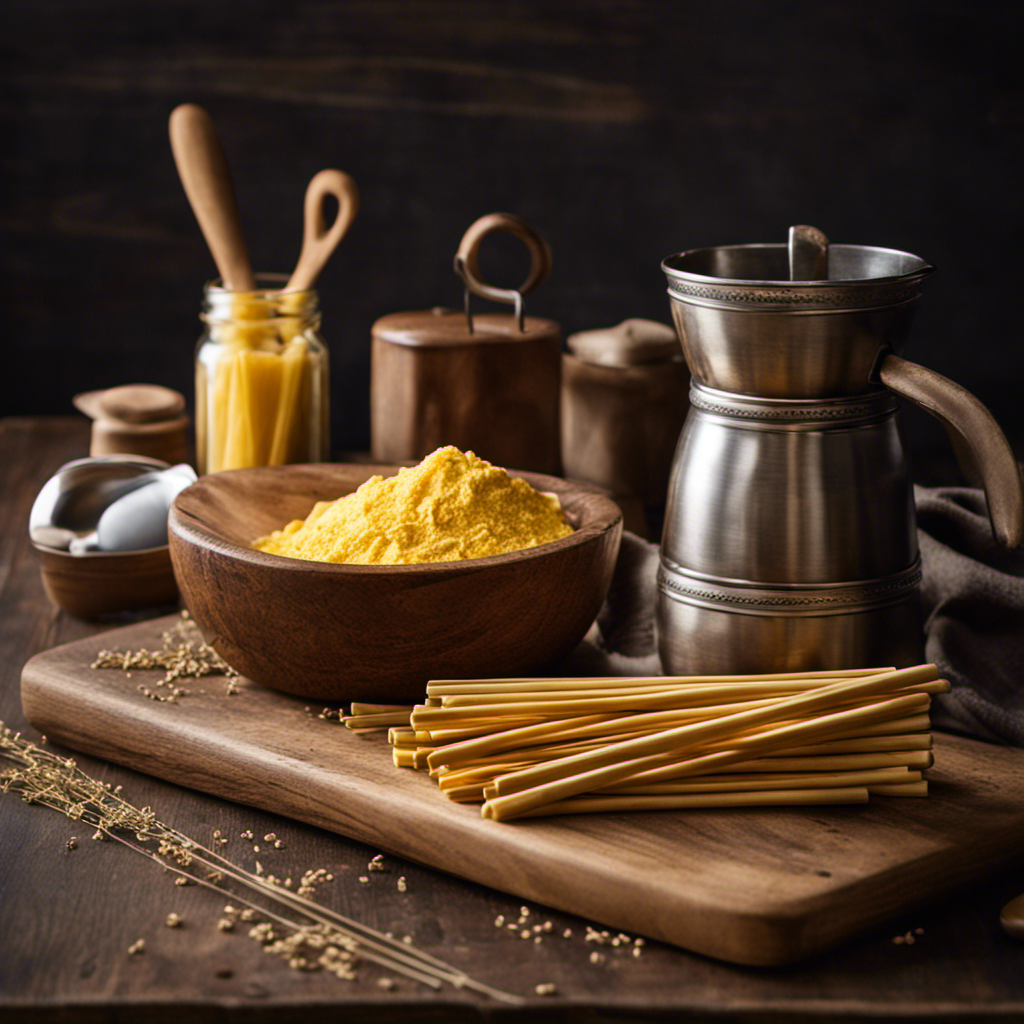I have always enjoyed the luxurious, smooth flavor of almond butter, but at times it can be quite challenging to spread. This is why I have dedicated numerous hours to testing various methods to achieve the perfect consistency for almond butter.
In this article, I’ll share with you my tried and tested methods that will transform your stubborn almond butter into a velvety smooth spread in no time.
Get ready to elevate your almond butter game and enjoy the satisfaction of effortlessly spreading it on your favorite snacks.
Key Takeaways
- Consider the ingredients and processing methods used in almond butter.
- Different almond varieties have unique flavor profiles, such as Marcona almonds and California almonds.
- Look for high-quality almond butter without added sugars or preservatives.
- Softening almond butter can be done through methods like microwave or stovetop, each with their own pros and cons.
Choosing the Right Almond Butter
When choosing the right almond butter, it’s important to consider the ingredients and the processing methods used. There are various almond varieties to choose from, each with its own unique flavor profile. Some popular options include Marcona almonds, which have a buttery and sweet taste, and California almonds, known for their slightly bitter and nutty flavor.
Additionally, it’s essential to look for almond butter that is made from high-quality almonds and does not contain any added sugars or preservatives. For nut butter lovers seeking alternative spreads, there are options like cashew butter, peanut butter, or even sunflower seed butter. These spreads offer a different taste and texture while still providing a nutritious and delicious option.
Now that we have explored the importance of choosing the right almond butter, let’s move on to the next section about using heat to soften almond butter.
Using Heat to Soften Almond Butter
To make it easier to spread, you can warm up your almond butter using gentle heat. There are two common methods for softening almond butter: using a microwave or a stovetop. Both methods have their benefits, so it ultimately comes down to personal preference.
When using a microwave, it is important to use short bursts of heat to prevent overheating and altering the texture of the almond butter. Start by placing the almond butter in a microwave-safe bowl and heat it for 10-15 seconds at a time, stirring in between each interval. This will help distribute the heat evenly and prevent any hot spots.
On the other hand, using a stovetop requires a bit more patience. Place your almond butter in a heat-resistant bowl and set it over a pot of simmering water. Stir occasionally until the almond butter reaches your desired consistency. This method allows for more control and prevents the almond butter from becoming too hot.
Both methods effectively soften almond butter, making it easier to spread. Just remember to use gentle heat and take your time to achieve the perfect texture.
Adding Liquid to Almond Butter
Adding a small amount of oil or water can help achieve a smoother consistency in your almond butter. When it comes to softening almond butter, there are alternative liquid options that can be used. Here are some methods you can try:
-
Heating methods:
-
Gently heat the almond butter in a microwave-safe container for short intervals, stirring in between, until it softens.
-
Place the almond butter in a heatproof bowl over a pot of simmering water, stirring occasionally until it becomes softer.
-
Alternative liquid options:
-
Add a teaspoon of oil, such as coconut or avocado oil, to the almond butter and mix it well.
-
Incorporate a small amount of water, gradually adding it while stirring until the desired consistency is achieved.
-
For a touch of sweetness, consider adding a drizzle of honey or maple syrup.
Mixing in Oil for a Softer Texture
By incorporating a small amount of oil, you can easily achieve a softer texture in your almond butter. Adding a liquid to almond butter is a common technique to make it smoother and easier to spread. While some people use water, I personally find that using oil yields better results. Oil helps to bind the almond particles together, creating a creamier consistency. When choosing the best type of oil to use, it’s important to opt for a neutral-flavored oil that won’t overpower the natural taste of the almonds. Popular options include avocado oil, grapeseed oil, and light olive oil. These oils have a mild taste and high smoke point, making them ideal for blending into almond butter. Experiment with different oils to find the one that suits your preference and enjoy a softer, more spreadable almond butter.
| Oil Type | Flavor Profile | Smoke Point |
|---|---|---|
| Avocado Oil | Neutral | 520°F |
| Grapeseed Oil | Neutral | 420°F |
| Light Olive Oil | Mild | 465°F |
Storing Almond Butter for a Smoother Consistency
When it comes to achieving a smoother texture in almond butter, two key factors come into play: temperature and mixing techniques.
First, the temperature at which you store your almond butter can greatly affect its consistency. By keeping it at room temperature or slightly warmer, the natural oils in the almonds will become more fluid, resulting in a smoother texture.
Second, the way you mix your almond butter can also contribute to its smoothness. Using a high-powered blender or food processor and incorporating intermittent scraping and pulsing techniques will help break down any clumps and create a velvety, creamy almond butter.
Temperature for Smoother Texture
To achieve a smoother texture, it’s important to warm the almond butter to the right temperature. This can be easily done by using a food processor. Here’s how:
-
Start by scooping the desired amount of almond butter into the food processor.
-
Turn on the food processor and let it run for a few minutes. The heat generated from the machine will help soften the almond butter.
-
If the almond butter is still too thick, you can add a small amount of honey for sweetness. This will not only enhance the flavor but also help in the softening process.
-
Continue processing until you reach the desired smoothness. Be sure to scrape down the sides of the processor bowl occasionally to ensure even blending.
Mixing Techniques for Smoothness
For a smoother texture, make sure you mix the almond butter thoroughly in the food processor. The food processor is one of the best mixing tools for almond butter as it helps break down the almonds into a creamy consistency.
Start by adding the desired amount of almond butter to the food processor and secure the lid tightly. Process the almond butter on high speed for about 2-3 minutes, stopping occasionally to scrape down the sides of the processor bowl. This will ensure that all the almond butter is evenly mixed and any clumps are eliminated.
If you’re experiencing issues such as a dry or lumpy texture, try adding a small amount of oil, such as coconut oil, to the almond butter to help loosen it up and improve the smoothness.
Blending Techniques for Creamy Almond Butter
If you want creamy almond butter, you should blend the almonds for a longer period of time. This will ensure that the almonds are broken down into a smooth and silky consistency.
When it comes to blending, there are a few key points to consider:
- Blender vs Food Processor:
- Blenders are great for small batches of almond butter, as they have sharp blades that can easily crush the almonds.
- Food processors are better suited for larger batches, as they have a larger capacity and more powerful motors.
Soaking Almonds:
- Soaking the almonds overnight can help soften them, making it easier to blend them into a smooth butter.
Time and Speed:
- Blend the almonds on high speed for at least 5 minutes, or until you achieve the desired creamy consistency.
By following these blending techniques, you can create a velvety almond butter that spreads effortlessly on toast or adds richness to your favorite recipes.
Now, let’s explore other tips and tricks for softening almond butter.
Other Tips and Tricks for Softening Almond Butter
When it comes to softening almond butter, there are a few key points worth discussing. One is whether to use the microwave or stovetop. In my experience, using the microwave is the quickest method. It only takes a few seconds to warm up the almond butter. However, some people prefer using the stovetop because it allows for more control over the temperature.
Another point to consider is whether to add oil or water. Adding a small amount of oil or water can help make the almond butter smoother and easier to spread. However, it’s important to be mindful of the amount used to avoid making it too runny.
Overall, the choice of method and whether to add oil or water depends on personal preference and desired consistency.
Microwave or Stovetop
To soften almond butter, you can use either the microwave or stovetop. Here are the pros and cons of each method:
Microwave:
- Pros:
- Quick and convenient.
- Requires less effort.
- Can soften almond butter in just a few seconds.
- Cons:
- May cause the almond butter to become too hot and lose its nutritional value.
- Can result in uneven heating if not done properly.
Stovetop:
- Pros:
- Allows for better control over heating.
- Maintains the nutritional value of almond butter.
- Provides a more even and thorough softening.
- Cons:
- Requires more time and effort.
- May require additional utensils for stirring.
Both methods have their advantages and disadvantages, so it ultimately depends on your preference and the time you have available.
Now, let’s move on to the next section about adding oil or water to soften almond butter.
Adding Oil or Water?
For a smoother texture, you can try adding a small amount of oil or water to your almond butter. Both oil and water can help soften the almond butter, but each method has its pros and cons. When it comes to adding oil, it can enhance the flavor and creaminess of the almond butter. However, it may also increase the calorie content. On the other hand, adding water can make the almond butter lighter and easier to spread, but it might dilute the flavor. To help you decide which method is best for you, here is a comparison table:
| Oil | Water | |
|---|---|---|
| Pros | Enhanced creaminess | Lighter texture |
| Cons | Increased calories | Diluted flavor |
| Best | Creamy consistency | Light and spreadable |
Ultimately, the choice between oil and water depends on your personal preference and dietary needs.
Frequently Asked Questions
How Long Does It Take for Almond Butter to Soften Using Heat?
Mixing almond butter with heat is an effective way to soften it. The time it takes depends on the amount of almond butter and the heat source used. Generally, it takes around 5-10 minutes of heating to achieve a softer consistency.
Can I Use Any Type of Oil to Mix Into Almond Butter for a Softer Texture?
Yes, you can use different types of oil to soften almond butter. Some popular options include coconut oil, avocado oil, and olive oil. Each oil has its own pros and cons in terms of taste and texture.
How Long Can I Store Almond Butter to Achieve a Smoother Consistency?
To achieve a smoother consistency in almond butter, I recommend storing it for at least a week. During this time, the natural oils will settle and make it easier to spread. Alternatively, you can try adding a small amount of oil to achieve a creamy texture.
Are There Any Alternative Methods to Blending Almond Butter for a Creamy Texture?
There’s more than one way to achieve a creamy texture with almond butter. I’ve discovered alternative methods that don’t involve blending, like adding a little oil or heating it gently.
Can I Add Any Type of Liquid to Almond Butter to Soften It?
Yes, you can add almond milk or any other type of liquid to soften almond butter. It will help to achieve a creamier texture and make it easier to spread.
Conclusion
In conclusion, softening almond butter is a simple yet crucial step to enhance its texture and make it more enjoyable to consume. By choosing the right almond butter, using heat, adding liquid or oil, and storing it properly, you can achieve a smoother consistency that spreads effortlessly.
Blending techniques also play a vital role in creating creamy almond butter. So, if you’re tired of struggling with thick and stiff almond butter, follow these tips and tricks to transform it into a velvety delight.
Get ready for a mouthwatering experience like never before!










